SYSTEM DESCRIPTION 1. TOUCH SWITCH OUTLINE (a) Touch switches are touch-sensitive (interactive) switches operated by touching the screen. When a switch is pressed, the outer film bends in to contact the inner glass at the pressed position. By doing this, the voltage ratio is measured and the pressed position is detected. 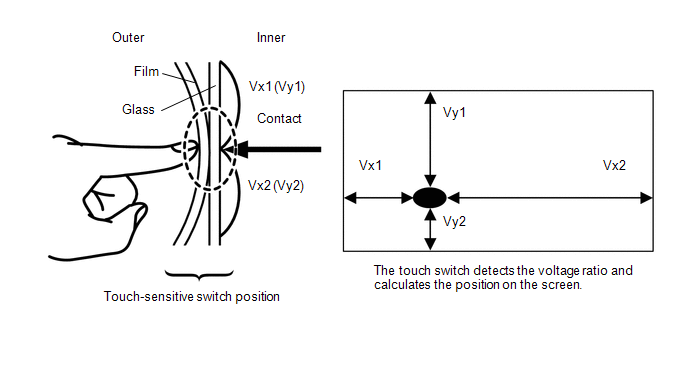 2. DISC PLAYER OUTLINE (a) A disc player uses a laser pickup to read digital signals recorded on a disc. By converting the digital signals to analog, it can play music, video and audio. CAUTION: Do not look directly at the laser pickup because the disc player uses an invisible laser beam. Be sure to operate the player only as instructed. NOTICE:
(b) This player can play only audio CDs, CD-Rs (CD-Recordable) and CD-RWs (CD-ReWritable) that have any of the following marks:  (c) The following products may not be playable on your player.
(d) Precautions for use of discs NOTICE:
HINT:
(e) Cleaning 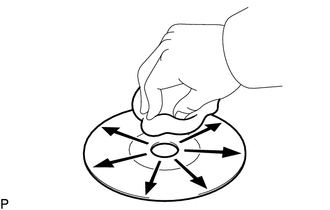 NOTICE: Do not use a lens cleaner because it may cause a malfunction in the pickup portion of the player. (1) If dirt is on the disc surface, wipe it clean with a soft dry cloth such as an eyeglass cleaner for plastic lenses from the inside to the outside in a radial direction. NOTICE:
3. MP3/WMA/AAC OUTLINE (a) Playable MP3 file standards
(b) Playable WMA file standards
(c) Playable AAC file standards
(d) ID3 tag, WMA tag and AAC tag (1) Additional text information called an ID3 tag can be input to MP3 files. Information such as song titles and artist names can be stored. HINT: This player is compatible with ID3 tags of ID3 Ver. 1.0 and 1.1, and ID3 Ver. 2.2 and 2.3. (Number of characters complies with ID3 Ver. 1.0 and 1.1.) (2) Additional text information called a WMA tag can be input to WMA files. Information such as song titles and artist names can be stored. (3) Additional text information called an AAC tag can be input to AAC files. Information such as song titles and artist names can be stored. (e) Usable media (1) Only CD-ROMs, CD-Rs (CD-Recordable), CD-RWs (CD-ReWritable) and USB device can be used to play MP3/WMA/AAC files. NOTICE:
(f) Usable media format (1) Usable media format
HINT:
(2) Standards and restrictions
(g) File names (1) Only files with an extension of ".mp3", ".wma" and ".m4a" can be recognized and played as MP3, WMA or AAC files. (2) Save MP3, WMA or AAC files with an extension of ".mp3", ".wma" or ".m4a". NOTICE: If non-MP3, non-WMA or non-AAC files are saved with an extension of ".mp3", ".wma" or ".m4a", those files may be wrongly recognized as MP3, WMA or AAC files and played. A loud noise may occur and damage to the speakers may result. 4. "Bluetooth" OUTLINE 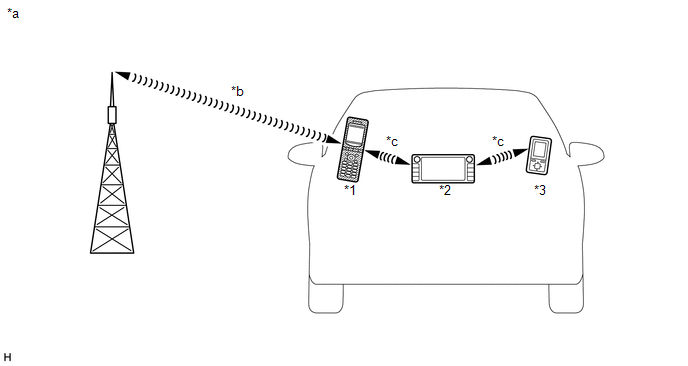 Text in Illustration Text in Illustration
(a) "Bluetooth" is a trademark owned by Bluetooth SIG, Inc. (b) "Bluetooth" is a wireless connection technology that uses the 2.4 GHz frequency band. HINT: The communication performance of "Bluetooth" may vary depending on obstructions or radio wave conditions between communication devices, electromagnetic radiation, communication device sensitivity or antenna capacity. (c) Hands-free function (1) The "Bluetooth" built-in radio and display receiver assembly and a "Bluetooth" compatible cellular phone* can be connected using a "Bluetooth" wireless connection. This enables the use of the hands-free function on the cellular phone even if the phone is in a pocket or bag. For this reason, it is not necessary to use a connector or cable to connect the cellular phone. *: Some versions of "Bluetooth" compatible cellular phones may not function. (2) Compatible hands-free devices
HINT: The amount of remaining battery charge displayed on the radio and display receiver assembly may be different from that of the "Bluetooth" device. (d) "Bluetooth" audio function (1) The "Bluetooth" built-in radio and display receiver assembly and a "Bluetooth" compatible portable audio player* can be connected using a "Bluetooth" wireless connection. This enables files stored in the portable audio player to be heard from the vehicle speakers. In addition, operations such as play/stop can be performed directly from the radio and display receiver assembly. *: Some versions of "Bluetooth" compatible audio players may not be able to operate the "Bluetooth" function, or music may play, but functions available using the radio and display receiver assembly may be limited. (2) Compatible "Bluetooth" audio devices
HINT: The amount of remaining battery charge displayed on the radio and display receiver assembly may be different from that of the "Bluetooth" device. 5. RADIO DESCRIPTION (a) Radio frequency band (1) Radio broadcasts use the radio frequency bands shown in the table below. 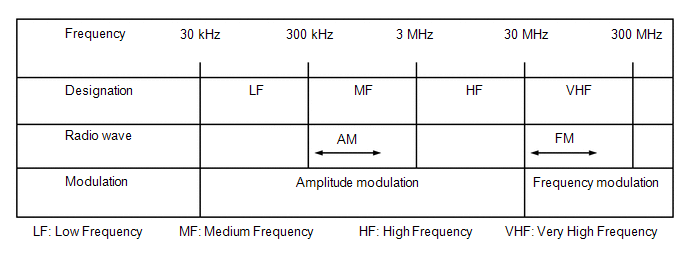 (b) Service area (1) The service areas of AM and FM broadcasts are vastly different. Sometimes an AM broadcast can be received very clearly but an FM stereo broadcast cannot. FM stereo has the smallest service area, and is prone to pick up static and other types of interference such as noise. 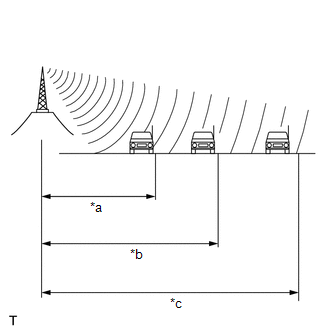 Text in Illustration Text in Illustration
(c) Radio reception problems HINT: In addition to static, other problems such as "phasing", "multipath" and "fade out" exist. These problems are not caused by electrical noise, but by the radio signal propagation method itself. (1) Phasing AM broadcasts are susceptible to electrical interference and another kind of interference called phasing. Occurring only at night, phasing is the interference created when a vehicle receives 2 radio wave signals from the same transmitter. One signal is reflected off the ionosphere and the other signal is received directly from the transmitter. 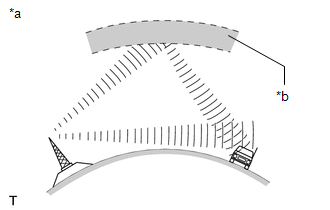 Text in Illustration Text in Illustration
(2) Multipath Multipath is a type of interference created when a vehicle receives 2 radio wave signals from the same transmitter. One signal is reflected off buildings or mountains and the other signal is received directly from the transmitter. 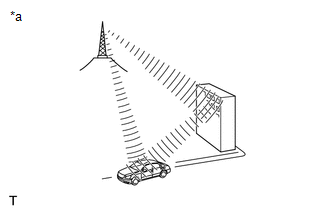 Text in Illustration Text in Illustration
(3) Fade out Fade out is caused by objects (buildings, mountains and other such large obstacles) that deflect away part of a signal, resulting in a weaker signal when the object is between the transmitter and vehicle. High frequency radio waves, such as FM broadcasts, are easily deflected by obstructions. Low frequency radio waves, such as AM broadcasts, are less likely to deflect. 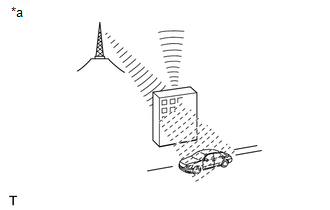 Text in Illustration Text in Illustration
(d) Noise problem Technicians must have a clear understanding about each customer's noise complaint. Use the following table to diagnose noise problems.
6. "HD Radio" FUNCTION OUTLINE (w/ HD Radio Function) (a) The "HD Radio" system is a radio system that broadcasts in the IBOC (In-Band On-Channel) form that the iBiquity Co. has developed. By expanding the bandwidth per channel of conventional FM/AM bands, digital audio and data signals are additionally transmitted. "HD Radio" technology is manufactured under license from iBiquity Digital Corporation. U.S. and Foreign Patents. "HD Radio" and the HD and HD Radio logos are proprietary trademarks of iBiquity Digital Corporation. Information for the music currently being listened to is stored in the system and can be transmitted to an "iPod" connected to the system. The information transferred to the "iPod" can be used for purchasing the music through the "iTunes" music store. Also, traffic and weather information can be received and displayed on the audio and visual screen. 7. SDARS SYSTEM FUNCTION OUTLINE (w/ SDARS System) (a) Satellite Digital Audio Radio Service (SDARS) is a satellite digital radio broadcast provided by Sirius XM Radio Inc. The broadcast (pay-type) is performed through satellites and terrestrial repeater networks. Several unique channels are available, and even if a vehicle changes locations, the same information can be received without breaks. Information such as song names, broadcast station names, etc. can be received. Also, traffic information can be received and displayed on the audio and visual screen. NOTICE: To receive audio-visual pay-type broadcasts, the customer must enter into a pay-type contract with XM Satellite Radio Inc. After entering into a contract, registration of the XM Radio ID is necessary. Also, if parts are replaced, the XM Radio ID must be re-registered. 8. MOBILE ASSISTANT FUNCTION OUTLINE (a) With a compatible Apple device connected via Bluetooth, this function allows the system to interface directly with "Siri" for voice recognition functions. The user operates the steering pad switch assembly to start the Mobile Assistant function and issues voice commands. HINT: "Siri" is trademarks of Apple Inc., registered in the U.S. and other countries. 9. CONNECTED NAVIGATION FUNCTION OUTLINE (a) Connected Navigation is a service that enables Connected Navigation applications and content of a cellular phone to be displayed on and operated from the radio and display receiver assembly screen. As "Bluetooth" communication is used for the communication between a cellular phone and the radio and display receiver assembly, before using the Connected Navigation service on the audio and visual system, the cellular phone needs to be registered with the audio and visual system as a "Bluetooth" device. For details regarding Connected Navigation operations, each of the applications and compatible phones, refer to http://www.toyota.com/entune/. 10. VEHICLE CUSTOMIZATION OUTLINE (a) Customization of functions can also be customized on the radio and display receiver assembly screen. Refer to Owner's Manual for further information on customizable items for the audio and visual system. HINT:
11. RBDS FUNCTION OUTLINE (w/ RBDS Function) (a) The Radio Broadcast Data System (RBDS) is broadcast through conventional FM radio broadcasts. Information such as song names, traffic information, broadcast station names, etc. can be received. 12. USB AUDIO SYSTEM FUNCTION OUTLINE (a) The No. 1 stereo jack adapter assembly is equipped with a USB terminal. Connecting a USB device or "iPod" to the No. 1 stereo jack adapter assembly allows music files to be played. Not only is it possible to play music from a USB device with audio functions, is also possible to play MP3 or WMA music files that are stored on a USB device. In addition, "iPod" control software is installed, allowing file selection from playlists and operation using shuffle mode. HINT: Operation through the controls of a USB device or "iPod" cannot be performed while it is connected. (b) USB audio system compatible devices (1) USB device The following device formats can be used:
MP3, WMA and AAC files written in any format other than those listed above may not play correctly, and their names and folder names may not be displayed correctly. Items related to standards and limitations are as follows:
(2) "iPod" "iPhone", "iPod", "iPod classic", "iPod nano" and "iPod touch" are trademarks of Apple Inc., registered in the U.S. and other countries. The following "iPod", "iPod nano", "iPod classic", "iPod touch" and "iPhone" devices can be used with this system. Made for:
HINT: Depending on differences between models or software versions etc., some models might be incompatible with this system. 13. CUSTOMIZE STARTUP IMAGE OR SCREEN OFF IMAGE FUNCTION OUTLINE (a) An image can be copied from a USB device. The image can be used as the startup image or screen off image of the audio and visual system. 14. AUTOMATIC SOUND LEVELIZER (ASL) FUNCTION OUTLINE (a) The Automatic Sound Levelizer (ASL) function automatically adjusts the audio system volume level in order to compensate for increased vehicle noise (vehicle noise tends to increase as vehicle speed increases). The ASL adjusts the volume level based upon vehicle speed signals that it receives from the combination meter assembly. 15. DIAGNOSTIC FUNCTION OUTLINE (a) The audio and visual system has a diagnostic function (the result is indicated on the master unit). 16. COMMUNICATION SYSTEM (a) Local Bus Communication Outline (for 7 or 9 Speakers) 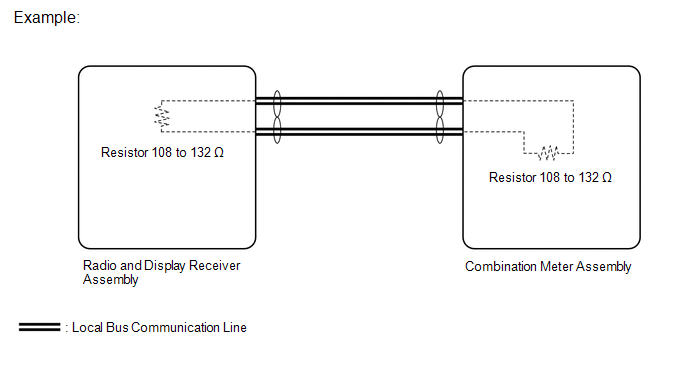 (1) Components of the audio and visual system communicate with each other via the local bus. (2) The local bus uses a twisted pair of wires for its communication lines. (3) The master unit of the local bus is the radio and display receiver assembly. HINT:
(b) CAN Communication Outline (1) The audio and visual system uses CAN communication between the radio and display receiver assembly and ECUs. (c) LVDS Communication Outline (1) The audio and visual system uses LVDS communication, between the radio and display receiver assembly and stereo component tuner assembly. (2) If a short or open circuit occurs in the LVDS communication line, communication is interrupted and the system will not operate normally. |
Toyota Tundra Service Manual > Steering Knuckle: Installation
INSTALLATION CAUTION / NOTICE / HINT HINT: Use the same procedures for the LH side and RH side. The procedures listed below are for the LH side. PROCEDURE 1. INSTALL KNUCKLE GREASE RETAINER CAP LH (for 2WD) (a) Using a brass bar and hammer, tap in a new retainer cap. NOTICE: The retainer cap is a no ...